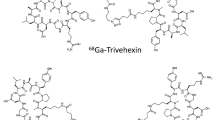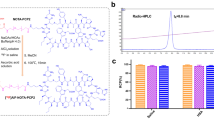Summary
The pharmacokinetics, tissue distribution and toxicity of the antitumour agentN-[2-(dimethylamino)-ethyl]acridine-4-carboxamide (AC) were studied after i.p. administration of [3H]-AC (410 μmol/kg) to mice. The latter is the optimal single dose for the cure of advanced Lewis lung tumours. AC was rapidly absorbed into the systemic circulation after i.p. administration, with the maximal concentration (C max) occurring at the first time point (5 min). There was no reduction in bioavailability as compared with previous i.v. studies, but the shape of the plasma concentration-time profile was considerably different, reflecting a 3-fold lowerC max value (20.9±3.6 μmol/l) and a longert 1/2 value (2.7±0.3 h) as compared with that observed after i.v. administration (1.6±0.6 h). Model independent pharmacokinetic parameters after i.p. administration were: clearance (C), 17.5 l h−1 kg−1; steady-state volume of distribution (Vss), 14.1 l/kg; and mean residence time (MRT), 1.46 h. High but variable tissue uptake of AC was observed, with tissue/plasma AUC ratios being 5.7 for heart, 8.4 for brain, 18.9 for kidney and 21.0 for liver but with similar eliminationt 1/2 values ranging from 1.3 to 2.7 h. All radioactivity profiles in plasma and tissues were greater than the respective parent AC profiles and showed prolonged eliminationt 1/2 values ranging from 21 h in liver to 93 h in brain. However, tissue/plasma radioactivity AUC ratios were near unity, ranging from 0.7 to 1.57, with the exception of the gallbladder (15.6), which contained greater amounts of radioactivity. By 48 h, approximately 70% of the total dose had been eliminated, with the faecal to urinary ratio being approximately 2:1. This i.p. dose was well tolerated by mice, with sedation being the only obvious side effect. No major change was observed in blood biochemistry or haematological parameters. Comparisons ofC max,t max and AUC values determined for AC in brain after its i.p. and i.v. administration suggest that the reduction in acute toxicity after i.p. administration is not due to reduced exposure of the brain to AC as measured by AUC but may be associated with the lowerC max value or the slower rate of entry of AC into the brain after i.p. administration.
Similar content being viewed by others
References
Cornford EM, Young D, Paxton JW (1992) A comparison of blood-brain barrier and liver penetration of acridine antitumour drugs. Cancer Chemother Pharmacol 29 (6): 439–444
Finlay GJ, Baguley BC (1989) Selectivity ofN-[2-(dimethyl-amino)ethyl]acridine-4-carboxamide towards Lewis lung carcinoma and human tumour cell lines in vitro. Eur J Cancer Clin Oncol 25: 271–277
Finlay GJ, Rewcastle GW, Baguley BC, Denny WA (1987) Potential antitumour agents: 50. In vivo solid tumour activity of derivatives ofN-[2-(dimethylamino)ethyl]acridine-4-carboxamide. J Med Chem 30: 664–669
Gibaldi M, Perrier D (1982) Noncompartment analysis based on statistical moment theory. In: Gibaldi M, Perrier D (eds) Pharmacokinetics. Marcel Dekker, New York, pp 409–417
Holford NHG (1985) MKMODEL, a modelling tool for microcomputers—a pharmacokinetic evaluation and comparison with standard computer programs (abstract). Clin Exp Pharmacol [Suppl] 9: 95
Oldendorf WH, Braun LD (1976) [3H]Tryptamine and [3H]water as diffusable internal standards for measuring brain extraction of radiolabelled substances following intracarotid injection. Brain Res 113: 219–227
Paxton JW, Young D, Evans SMH, Robertson IGC, Kestell P, Cornford EM (1992) Pharmacokinetics and toxicity ofN-[2-(dimethylamino)ethyl]acridine-4-carboxamide in the mouse after i.v. administration. Cancer Chemother Pharmacol 29 (5): 379–384
Robertson IGC, Palmer BD, Officer M, Lawson V, Paxton JW, Bland T (1992) Metabolism of the experimental antitumour agent acridine carboxamide (AC) in the mouse. Drug Metab Dispos (in press)
Young D, Evans PC, Paxton JW (1990) Quantitation of the antitumour agentN-[2-(dimethylamino)ethyl]acridine-4-carboxamide in plasma by high performance liquid chromatography. J Chromatogr Biomed Appl 528: 385–394
Author information
Authors and Affiliations
Additional information
This study was supported by the Cancer Society of New Zealand. The senior author (S.M.H.E.) is the recipient of a Health Research Council of New Zealand Junior Research Award
Rights and permissions
About this article
Cite this article
Evans, S.M.H., Young, D., Robertson, I.G.C. et al. Intraperitoneal administration of the antitumour agentN-[2-(dimethylamino)ethyl]acridine-4-carboxamide in the mouse: bioavailability, pharmacokinetics and toxicity after a single dose. Cancer Chemother. Pharmacol. 31, 32–36 (1992). https://doi.org/10.1007/BF00695991
Received:
Accepted:
Issue Date:
DOI: https://doi.org/10.1007/BF00695991




